In December 2022, I spent an unforgettable two weeks in Spain with my family. This hugely diverse nation is home to unique cultural norms that set it apart from its neighbours. Travelling there, we had to make small adjustments and get used to an unfamiliar rhythm of life. Nonetheless, it was the things that caught us by surprise that made our family trip to Spain a memorable one.
Also read: 10 Best Airbnb Homes in Spain, From Barcelona to Ibiza
What I didn’t expect from our family trip to Spain
1. Late lunch and dinner hours
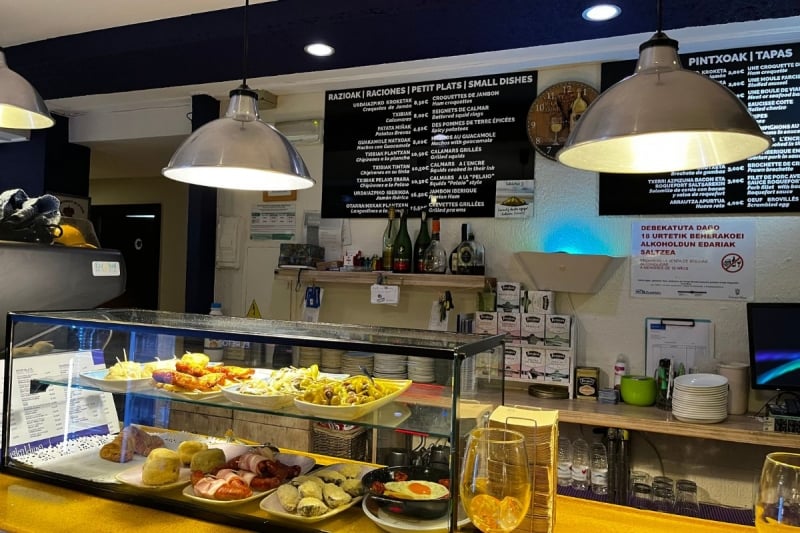
A tapas restaurant in Santiago
Looking up “Spain restaurants” on Google, I found that dinner reservations typically start between 8 and 8.30pm. One seafood restaurant in Madrid started reservations at 6.30pm, or so it seemed. When we arrived at that time, the indoor seating area was empty. Outside, a couple of customers were relaxing over alcoholic drinks in the wintry December air.
A waiter emerged from the back of the restaurant to inform us that they take dinner orders only from 8pm. Until then, customers may enjoy some drinks and light refreshments. He thought we reserved a table early in the evening for this purpose. In the end, we frittered away a pleasant one-and-a-half hours browsing the restaurant’s menu. Sipping warm coffee and cool wine, time passed too quickly for us to get bored.
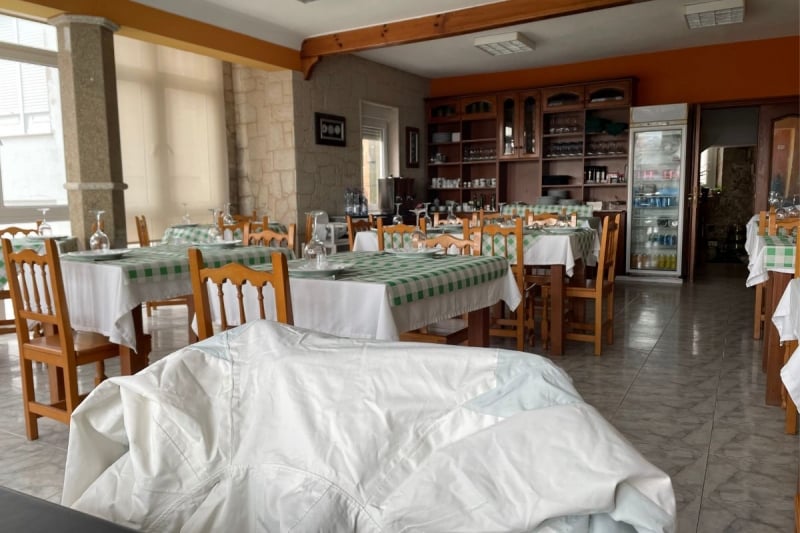
A seafood restaurant in Fisterra, Galicia. We had the whole restaurant to ourselves at 1pm.
In Spain, lunch usually starts at 1pm and dinner at 8pm. Most locals dine later, which meant that we were often among the first few customers at a restaurant. When we asked our tour guides about this custom, each of them gave a different answer. One of them attributed later meal times to sweltering summers which make it difficult to go out earlier in the day. Another said that working hours end later in Spain, resulting in late dinners.
Also read: What It’s Like Planning & Executing a Mega Family Vacation Without Going Crazy
2. Siesta culture
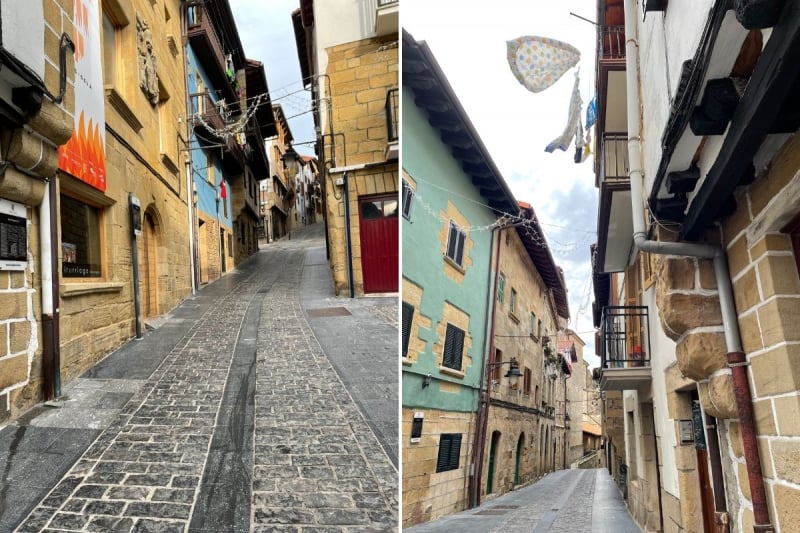
The small Basque town of Orio during siesta hours
Another special feature of life in Spain is the siesta. This is a “napping period” from around 2pm to 5pm. Of course, most locals in Spain with nine-to-five jobs wouldn’t be able to nap during these hours. All the same, employees in Spain do rest for a bit after lunch, so shops, restaurants, and attractions tend to close in the middle of the day. In small towns, the streets can get eerily quiet with shuttered storefronts and few people outside.
It is a little inconvenient that you can’t go out to buy stuff whenever you want in the afternoon. Nonetheless, siesta hours are a great opportunity to catch a breather from shopping and sightseeing. Moreover, you can take advantage of the empty streets that are perfect for taking photos. You won’t get any photobombers in your shot!
Also read: A Spain ‘Digital Nomad’ Visa Is Currently in the Works
3. Narrow roads in some destinations
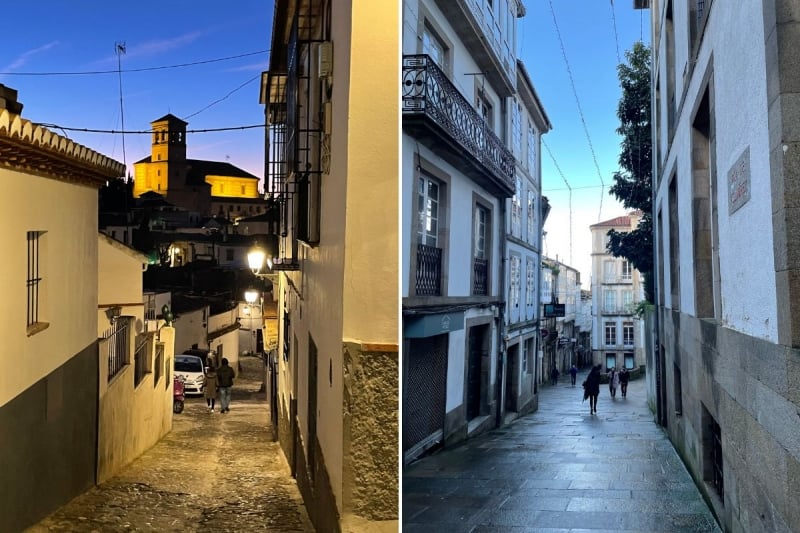
(L-R): Granada’s old town; Santiago de Compostela’s old town
Driving in Spain can be a risky endeavour. Reckless drivers may find themselves stuck in the narrow roads characteristic of Spanish old towns. Some streets are so compact that you can reach out your arms from the car window and touch the walls.
Touring Granada’s Albaicin district, we came across a comical scene. Three mini-hatchbacks were trapped in a cramped back alley, one after another. A lot of honking ensued. According to our tour guide, some drivers follow the GPS blindly, neglecting the fact that the GPS does not account for the car’s width. This was why he discouraged us from going on a self-drive family trip in Spain.
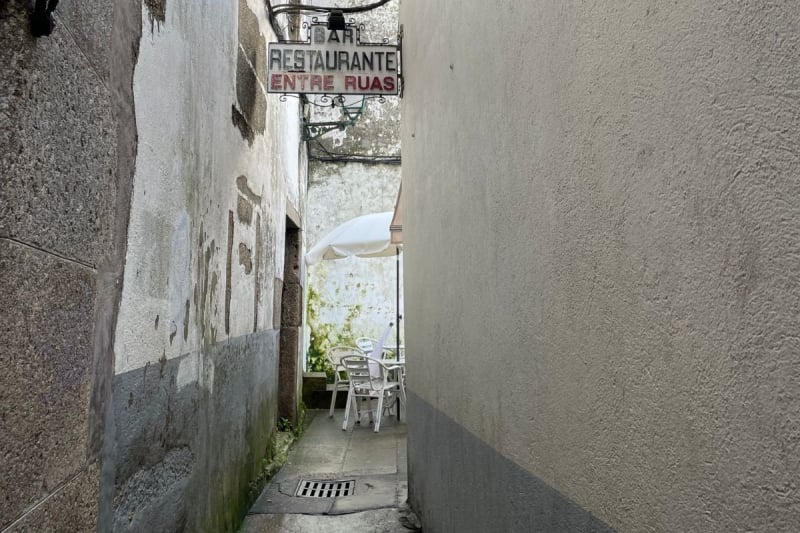
Believe it or not, this is a street in Santiago de Compostela.
Although we didn’t drive in Spain, we found old-town roads a challenge to navigate. Many of these roads are used by both pedestrians and motorists, even if they look too narrow for vehicles to get through. Many times, we had to press ourselves against the walls to let vehicles pass.
4. Cold rainy days during winter and spring
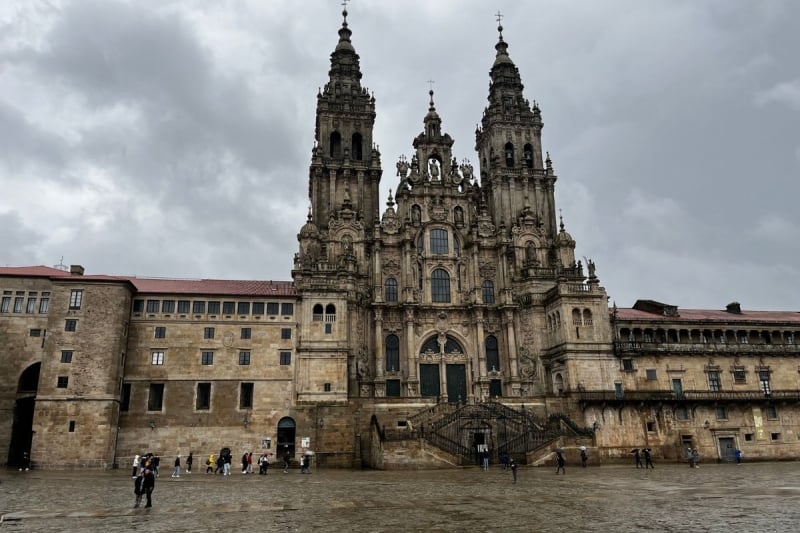
The Cathedral of Santiago on a rainy day. This cathedral is the reputed burial place of St. James and has been an important pilgrimage site since the ninth century.
Stepping out of the train station in Santiago de Compostela, we were greeted by a frigid downpour. Unwilling to shell out for a taxi ride to our hotel, we dragged three heavy suitcases over slippery grounds. By the time we arrived, my socks and shoes were drenched.
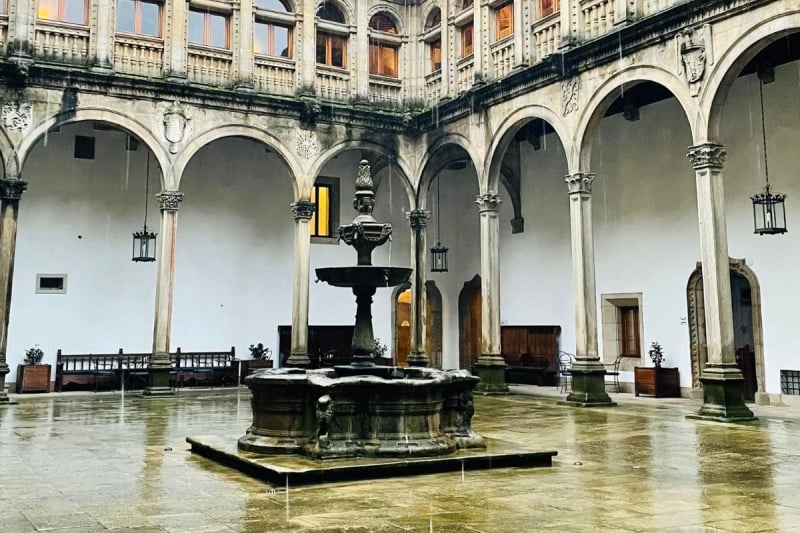
A courtyard in our Santiago hotel, The Paradores, formerly a hostel for pilgrims
Before coming to Spain, I associated the Mediterranean region with sunny days and warm nights. Those three days in Santiago reminded me of the region’s diversity in climate. Santiago is a city in Galicia, a northern province known for cold, rainy weather similar to that of faraway England. Summers are warm and dry, but the region experiences high rainfall in winter and spring. On some days, the rain never stops. You’ll have to get used to sightseeing under an umbrella.
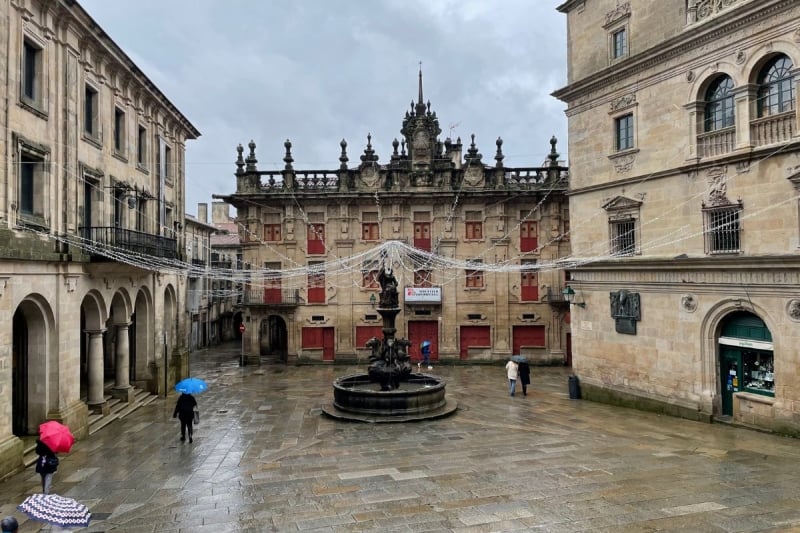
Platerías Square, Santiago de Compostela. A typical arched walkway in Galicia can be seen on the left.
In Galicia, the historic streets are lined with arched walkways that provide cover from the wind and rain. Our first tour in Santiago started under one of these arches. The guide had asked us to take cover from the light shower while she went over the city’s history.
After we told her that our portable umbrellas had been turned inside out by the strong wind, she showed us something interesting. The locals in Santiago use umbrellas with an extra frame to make them sturdier. You can buy windproof umbrellas online for around S$12, or get one at any of Santiago’s gift shops.
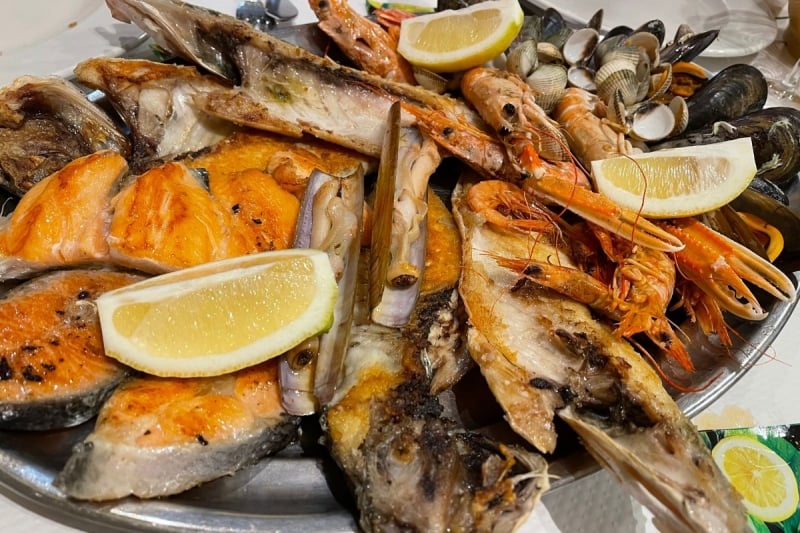
A Galician seafood platter meant for two people
A chilly and wet Mediterranean holiday may not sound appealing. Yet, Santiago turned out to be the highlight of our family trip in Spain. It was fascinating to see how the locals adapted to their environment through their architecture and everyday items.
Furthermore, the food there was incredible. Situated near the sea, Galicia serves up the freshest seafood in the country. Many restaurants offer seafood platters for two people with scallops, prawns, turbot, mussels, and more. These platters are simple and sumptuous; quality ingredients do not require much seasoning. Portion sizes can be quite large, so I recommend ordering a two-person platter for three people.
Other dishes to try include lobster paella and Galician fish stew. At one of the restaurants we went to, they cooked lobster paella fresh on our table with an iron pot. After waiting for ten minutes, we were able to savour steaming hot paella soaked in lobster juice!
5. A different way of ordering coffee
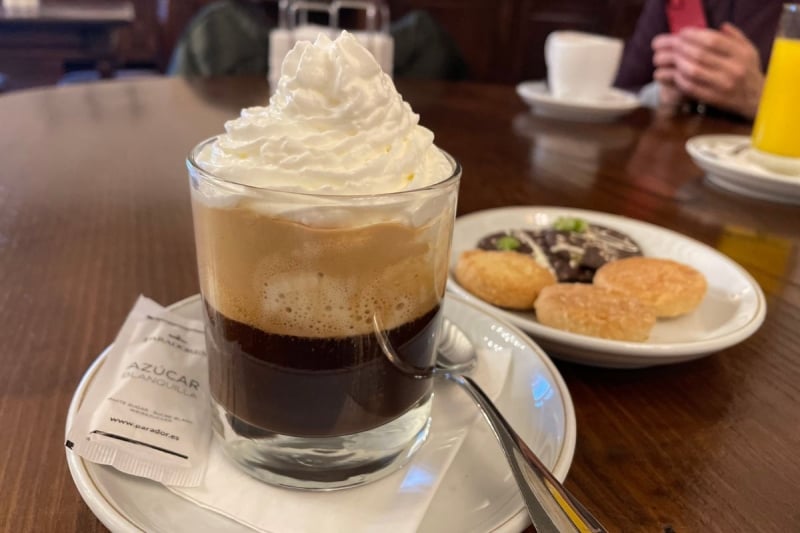
A café vienés I ordered at the cafe of our hotel in Santiago
Our first time ordering coffee in Spain was at a busy train station cafeteria. After waiting in line for 15 minutes, my father ordered two lattes and two americanos. We were served two cups of warm milk and two americanos. Unwilling to queue again, the four of us learned our lesson and started looking up the different Spanish terms for coffee.
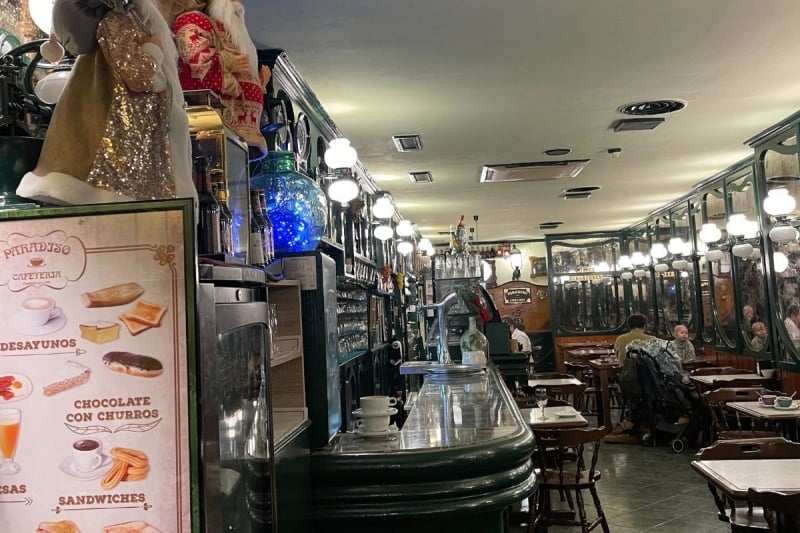
A typical Spanish churreria (churros cafe) in Santiago
In Spain, the café (coffee) names are different from what you might find at a Starbucks outlet. A latte is a café con leche (coffee with milk), while single-shot espresso is café solo. Coffee with cream is café vienés and an americano is still an americano, strangely enough.
Other useful terms to know are cacao con leche (cocoa with milk), leche caliente (hot milk), azúcar (sugar), and naranja (orange juice). If you’re ordering the sticky hot chocolate to dip churros in, just say chocolate con churros (pronounced as “cho-ko-la-teh”).
With the right vocabulary, our drink orders went off without a hitch for the rest of the family trip in Spain.
Also read: 15 Countries With a Coffee Culture Worth Travelling For
6. No photos allowed inside certain places
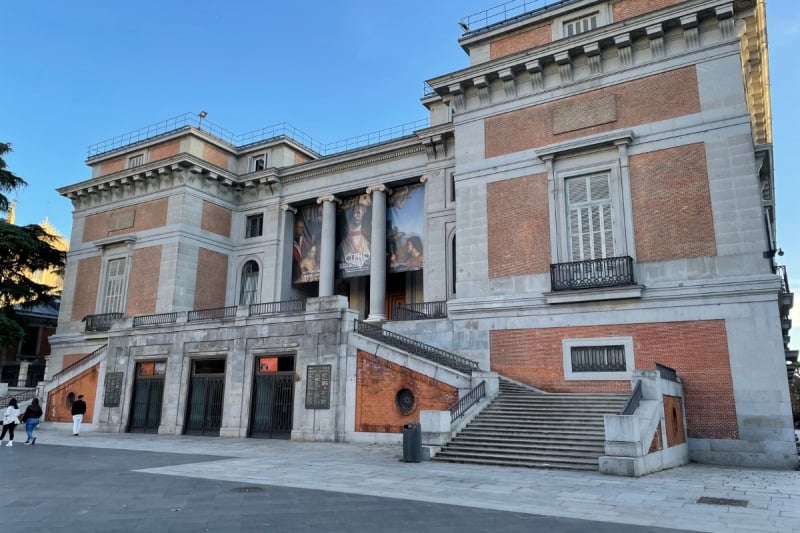
The Prado Museum has a strict no-photos policy.
In Spain, some attractions do not allow visitors to take photos. Two of the most notable ones are the Prado Museum and the Royal Palace in Madrid. Attractions put up signs in the exhibits that disallow photography and staff members keep a watch on the visitors.
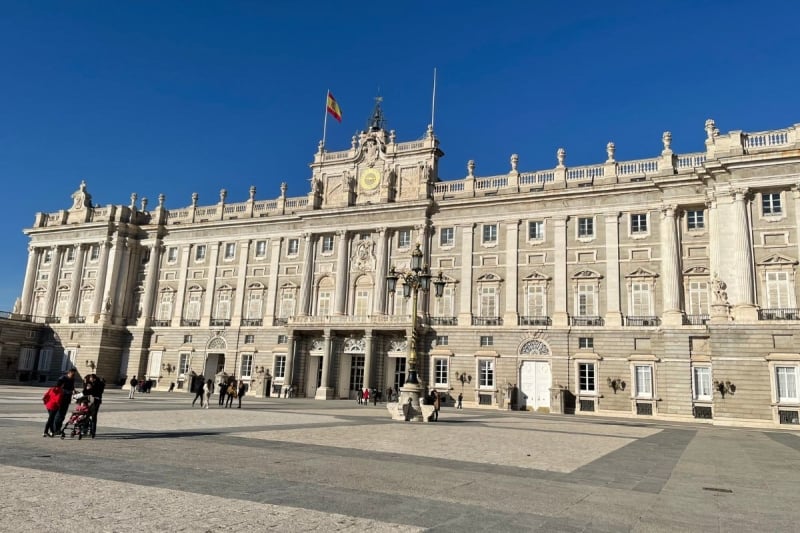
The Royal Palace in Madrid, where only a few exhibits allow photos.
I found this a highly unusual requirement. Typically, museums only prohibit flash photography. At the Royal Palace, our guide told us that the strict no-photography policy gets visitors to move through the exhibits faster. Otherwise, they would spend a long time taking photos and block the path of other visitors.
While being unable to take photos may be disappointing, it helps in getting you to focus on the artefacts themselves. Without a camera in the way, I could see these precious objects with my own eyes the entire time. Rather than trying to find the best angles, I spent my visit reading artefact descriptions and thinking about what they might represent.
Also read: 3 Cities to Discover the Islamic Heritage in Moorish Spain
Top tips for a family trip to Spain
1. Bring your own snacks
If you’re used to having lunch and dinner early, one of the best Spain travel tips is to bring along some snacks. That way, you can eat something small before meals, on the go, or in the hotel room when you don’t feel like going out.
Also read: How I Backpacked Through Europe in 20 Days as an Exchange Student
2. Look out for traffic in the old towns
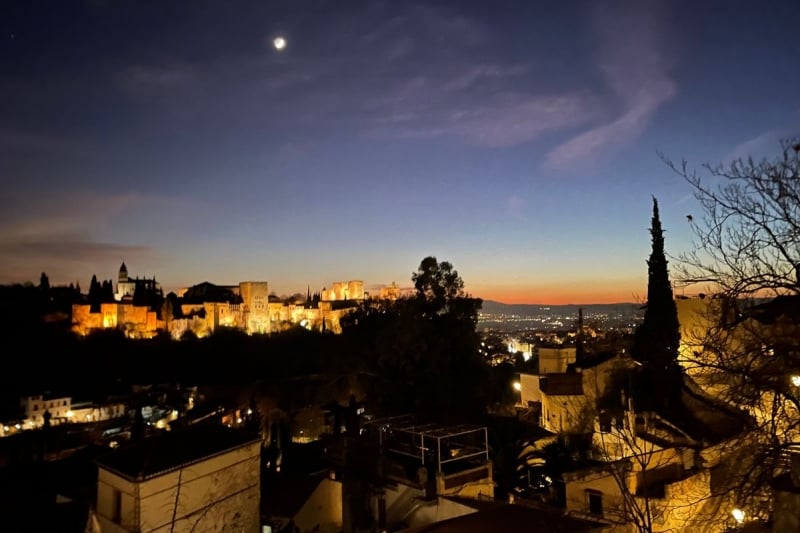
Granada’s Albaicin district at sunset
Drivers and pedestrians often share the roads in Spanish old towns. While snapping photos of picturesque cobbled streets, you might not notice an approaching vehicle. For your safety, stay alert and look out for oncoming traffic when in these areas.
3. Check the opening hours
Some attractions close in the afternoon for the siesta, so it would be prudent to check their opening hours to avoid wasted trips. Another thing to note is that cathedrals and churches may not be open to visitors when a mass is ongoing.
4. Download a menu translation app
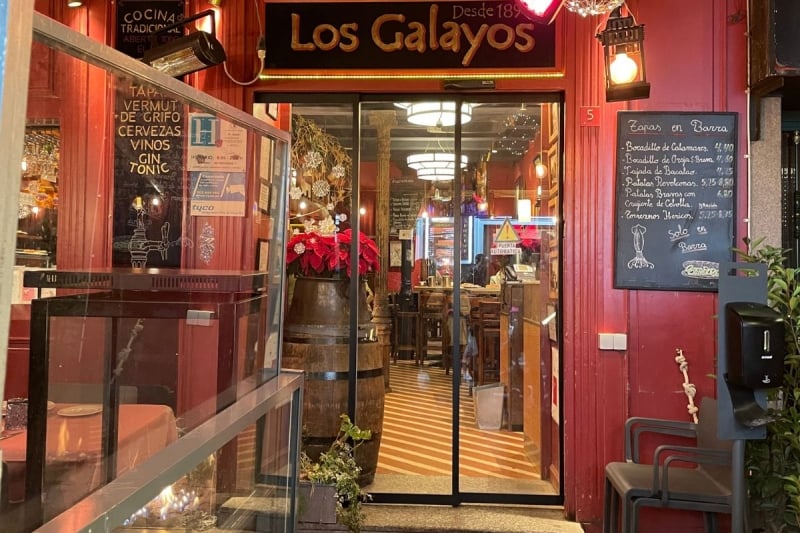
A traditional Spanish restaurant in Madrid
Not all restaurants and cafes in Spain have an English menu. This is usually the case outside major tourist areas. No worries — you’ll be all set after downloading an app like Cibo or PicTranslator that can translate visual input. This is one of the Spain travel tips that will save you a lot of time.
You will no longer have to translate menu items one by one using Google Translate. With a single snap, an English version of the menu will appear on your phone screen.
Also read: 50 Essential Spanish Phrases for Your Next Vacation
As I reflect on my favourite parts of those two weeks in Spain, only a few of the country’s famous attractions come to mind. Instead, it’s mostly the days of aimless wandering and evenings spent drinking coffee that linger in my memory.
What I took away is that changing your habits is not an inconvenience, but rather a quintessential aspect of travelling. When we travel, we shift not just our bodies, but also our ways of thinking and doing. It’s this internal shift that makes travelling such an eye-opening experience.
Have you ever faced unexpected situations during a trip? Share your stories with us and you just might become our next Featured Traveller!
All images courtesy of Joyce Lee.





